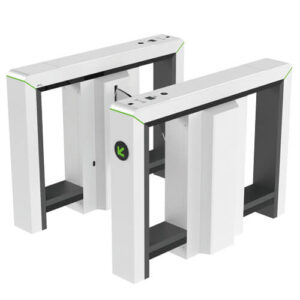
Introduction to Turnstile Access Control
Welcome to the realm of security turnstiles – the unsung heroes of security and access control. For anyone who has stepped into a stadium, visited a commercial building or used public transport, encountering a turnstile is almost inevitable. Yet, few appreciate their complexity and the significance they bring to the table in terms of streamlining building entry and ensuring safety.
The Purpose and Functionality of Turnstile Access Control Security Gates
So, what are turnstiles used for? At their core, turnstiles serve as barriers. They regulate pedestrian traffic, ensuring individuals gain access one at a time, thereby increasing security. But their functionality doesn’t just stop there. With advancements in technology, turnstiles have evolved from being mere entry and exit points to sophisticated tools that integrate seamlessly with other access control systems.
Manual vs. Automatic Turnstiles
Comparing manual and automatic security turnstiles gates, the former requires a push or pull action from the user, while the latter, often seen in modern settings, uses electronic mechanisms. Automatic turnstiles might use ticketing, card readers, or even biometric verification for access control.
Turnstiles: A Brief Historical Glimpse
Turnstile Access Control, dating back centuries, started as livestock herders before evolving into today’s advanced access controls. With urbanisation, they transitioned from farms to managing human traffic, especially during the Industrial Revolution, aiding in rapid transit systems and fare collection. Modern turnstiles now boast biometric features and contactless access. For a comprehensive history, check our detailed guide on Turnstile Evolution. View the history as per Wikipedia (Opens in a new Tab)
Diving Deep into Turnstile Designs
From full-bodied barriers to waist-high gates, turnstiles come in varied shapes and sizes. The difference between a full-height turnstile and a waist-high turnstile isn’t just aesthetic. Full-height turnstiles are ideal for high-security areas, ensuring a more rigorous access checkpoint, whereas waist-high options are more about streamlining large pedestrian traffic with moderate security needs.
The Different Types of Turnstiles
Full-Height vs. Waist-Height Turnstile Access Control:
- Full-height turnstiles: Found in high-security areas like stadiums and large event venues. Their robust design ensures controlled entry, minimising security breaches. You can view an example at the ZKTeco FHT2300 page.
- Waist-high turnstiles: Common in metros and commercial buildings, these are ideal for areas requiring rapid access with a moderate security level.

Full-Height Turnstiles
In scenarios where crowd control and robust security are crucial, these turnstiles stand tall, literally and figuratively.

Swing Barriers
These barriers blend efficiency with smooth user flow, managing people without causing bottlenecks. View the promotional video here or explore the range here.

Tripod Turnstiles
Compact and efficient, these turnstiles function with minimal noise and power. Crafted from resilient stainless steel, they fit seamlessly even in constrained spaces. View the promotional video here or explore the range here.

Flap Barriers
Similar to swing barriers, flap barriers employ retractable flaps, harmonising style with function. Check them out here.
Materials Matter
The best materials for outdoor turnstiles need to withstand external environmental factors, and hence, stainless steel and galvanised metal are commonly used. For indoor settings, a combination of metals, glass, and even toughened plastics might be preferred.
Integration with Modern Systems: Elevating Security
Modern turnstiles seamlessly mesh with cutting-edge security systems. Their integration with CCTV, alarms, and monitoring tools crafts a robust security fabric, enhancing oversight for every entry or exit. A hallmark of NZTeco’s turnstiles is their unparalleled adaptability. While some systems can be limiting, ours are designed with a clear focus on universality. They effortlessly pair with any 3rd party access control, a testament to their simplistic design which relies on dual-input triggers: one for entry and the other for exit. This ensures that, no matter the intricacy of your current security setup, our turnstiles amplify and integrate without complexities, solidifying your premises’ security.
Tech Integration in Modern Turnstile Gates
Most modern turnstiles are integrated with biometric readers, card systems, and even smartphone access. ZKTeco, for instance, has a plethora of integration solutions, streamlining access control and security for businesses across New Zealand.
Turnstile Access Control in Action: Real-Life Cases
Turnstiles are indispensable in venues like:
- Sports stadiums: Managing large crowds.
- Corporate buildings: Streamlining employee entry.
- Transport stations: Controlling public access.
For a more in-depth look, visit the ZKTeco’s turnstiles range.
Maintenance and Lifespan
A well-maintained security turnstile gate can last years, with the average lifespan of a turnstile ranging between 5 to 10 years or even more. Regular inspections, adhering to turnstile maintenance tips, and prompt repairs can ensure they remain in prime working condition. If you’re considering an installation, check out ZKTeco’s product range and their price match promise.
Conclusion
Security Turnstile Gates, be it for commercial buildings or public venues, play a pivotal role in enhancing security and streamlining access. With myriad designs, functionalities, and integration capabilities, they remain a cornerstone for access control with turnstiles. Whether you’re considering a turnstile installation or simply wish to learn more about their benefits, a deeper dive can indeed be enlightening.






















